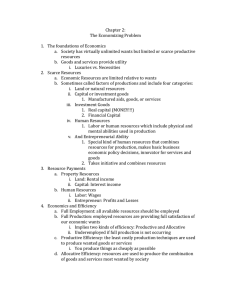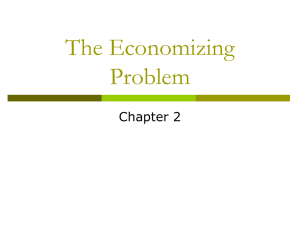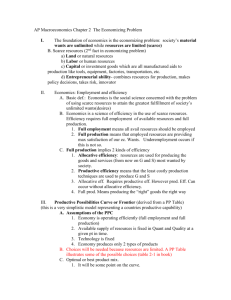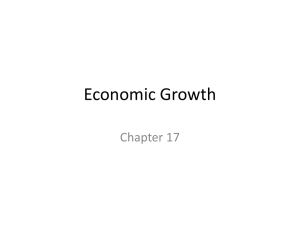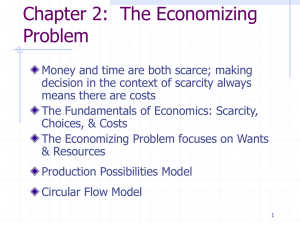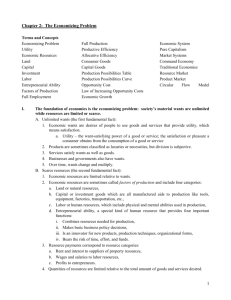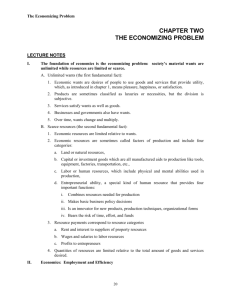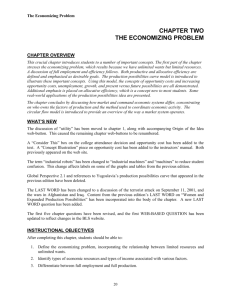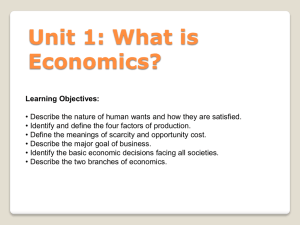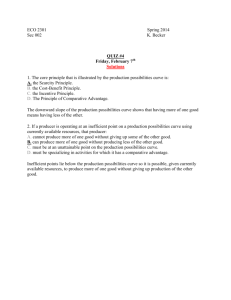The Economizing Problem Economic Systems Lecture 3 & 4 Outline
advertisement
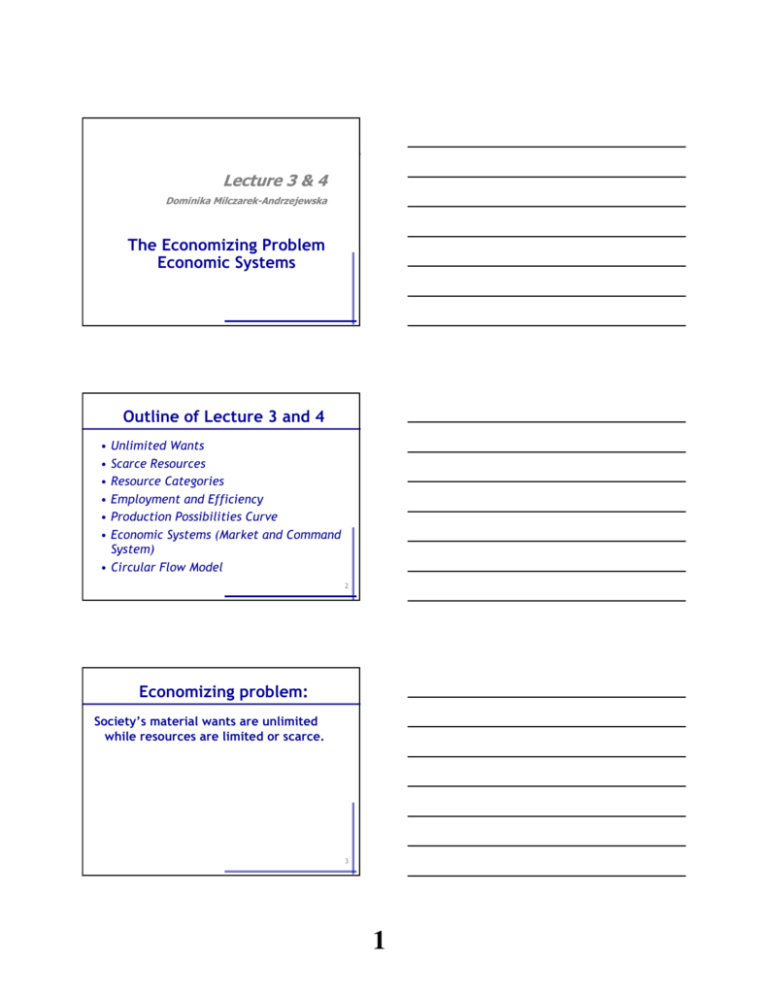
Lecture 3 & 4 Dominika Milczarek-Andrzejewska The Economizing Problem Economic Systems Outline of Lecture 3 and 4 • • • • • • Unlimited Wants Scarce Resources Resource Categories Employment and Efficiency Production Possibilities Curve Economic Systems (Market and Command System) • Circular Flow Model 2 Economizing problem: Society’s material wants are unlimited while resources are limited or scarce. 3 1 Unlimited Wants (The First Fundamental Fact) 1. Economic wants - desires of people to use goods and services that provide utility 2. Luxuries or necessities 3. Services satisfy wants as well as goods 4. Businesses and governments also have wants 5. Over time, wants change and multiply 4 Scarce Resources (The Second Fundamental Fact) • Economic resources - limited relative to wants • Economic resources - sometimes called factors of production • Four categories: – Land or natural resources, – Capital or investment goods (tools, equipment, factories, etc.) – Labor or human resources – Entrepreneurial ability 5 Employment and Efficiency • Economics is a science of efficiency in the use of scarce resources. • Efficiency requires: – full employment of available resources and – full production 6 2 Allocative and Productive Efficiency Full production: employed resources are providing maximum satisfaction of our economic wants. Full production implies two kinds of efficiency: 1. Allocative efficiency - resources are used for producing the combination of goods and services most wanted by society 2. Productive efficiency - least costly production techniques are used 7 Allocative and Productive Efficiency • Allocative efficiency requires productive efficiency • Productive efficiency can occur without allocative efficiency 8 Production Possibilities Assumptions: 1. Economy is operating efficiently 2. Available supply of resources is fixed in quantity and quality at this point in time 3. Technology is constant during analysis 4. Economy produces only two types of products • Choices will be necessary because resources and technology are fixed • A production possibilities curve is a graphical representation of choices 9 3 Production Possibilities cars (thousands) Q 13 12 11 A B 10 9 C 8 7 D 6 5 Attainable 4 but 3 Inefficient 2 1 1 2 3 TV sets Unattainable W Attainable & Efficient E 4 5 6 7 (hundred thousands) 8 Q 10 Law of Increasing Opportunity Costs Opportunity cost - the amount of other products that must be foregone to obtain more of any given product • The more of a product produced the greater is its opportunity cost • The slope of the production possibilities curve becomes steeper, demonstrating increasing opportunity cost. 11 Allocative Efficiency Revisited How does society decide its optimal point on the production possibilities curve? – It is advantageous to have the additional product if MB > MC – It is not “worth” it to society to produce the extra unit if MB < MC 12 4 Allocative Efficiency: MB=MC Marginal Benefit & Cost P MC $15 MB=MC 10 5 MB 1 2 Q 3 Quantity of TV sets 13 Unemployment and Growth • Unemployment and productive inefficiency – the economy is producing less than full production or – inside the curve • In a growing economy, the production possibilities curve shifts outward – when resource supplies expand in quantity or quality – when technological advances are occurring 14 Production Possibilities cars (thousands) Q Unemployment & Underemployment Shown by Point U 13 12 11 10 9 8 7 6 5 4 3 2 1 More of either or both is possible U 1 2 3 4 5 6 TV sets (hundred thousands) 7 8 Q 15 5 Production Possibilities cars (thousands) Q 14 A’ 13 12 11 10 9 8 7 6 5 4 3 2 1 Economic Growth C’ B’ D’ E’ 1 2 3 4 5 6 7 TV sets (hundred thousands) 8 Q 16 International Trade • A nation can avoid the output limits of its domestic Production Possibilities through international specialization and trade • Specialization and trade have the same effect as having more and better resources of improved technology 17 Economic Systems • Differences: – Who owns the factors of production and – The method used to coordinate economic activity 18 6 Economic Systems • The market system: – There is private ownership of resources; – Markets and prices coordinate and direct economic activity; – Each participant acts in his or her own selfinterest; – In pure capitalism the government plays a very limited role; – In the European version of capitalism, the government plays a substantial role. 19 Economic Systems • Command economy, socialism or communism: – There is public (state) ownership of resources. – Economic activity is coordinated by central planning. 20 The Circular Flow Model • Two groups of decision makers in the private economy: households and businesses • The market system coordinates these decisions. 21 7 The Circular Flow Model $ COSTS $ INCOMES RESOURCE MARKET RESOURCES INPUTS BUSINESSES HOUSEHOLDS GOODS & SERVICES GOODS & SERVICES PRODUCT MARKET $ REVENUE $ CONSUMPTION 22 The Circular Flow Model Limitations of the model: • No transactions between households and businesses • Lack of government and the “rest of the world” • Lack of explanation how prices of products and resources are determined 23 Key Terms • ECONOMIC RESOURCES • FACTORS OF PRODUCTION • FULL EMPLOYMENT • FULL PRODUCTION • PRODUCTIVE EFFICIENCY • ALLOCATIVE EFFICIENCY • PRODUCTION POSSIBILITIES TABLE • PRODUCTION POSSIBILITIES CURVE • OPPORTUNITY COST • LAW OF INCREASING OPPORTUNITY COST • ECONOMIC GROWTH • ECONOMIC SYSTEM • MARKET SYSTEM • CAPITALIZM • COMMAND SYSTEM • RESOURCE MARKET • PRODUCT MARKET • CIRCULAR FLOW MODEL 24 8
